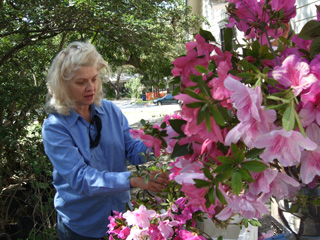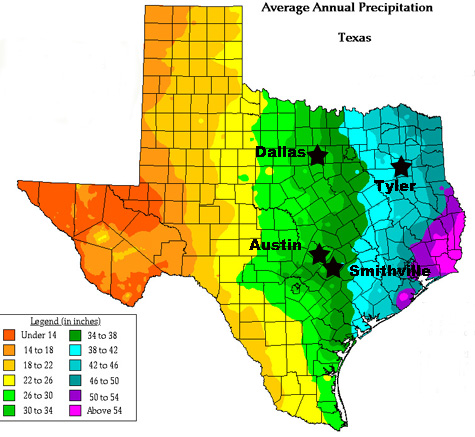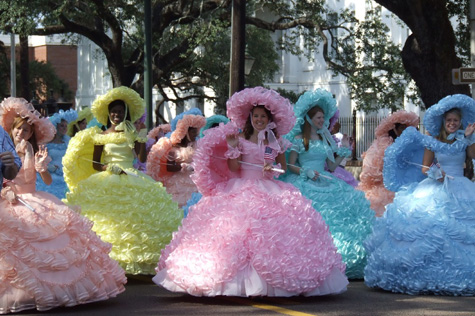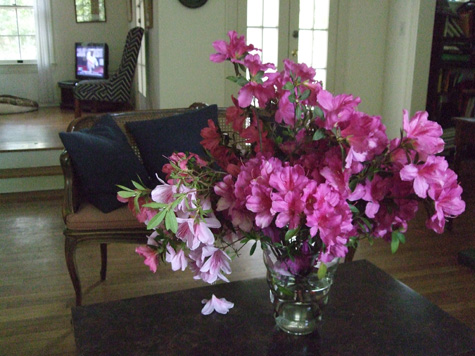Human Flower Project
The Azalea Line
In the U.S., the hardiness zone for these low-growing rhododendrons has a cultural wall on the western front.

Wanda Gamble of Smithville, Texas, delivers blooming branches to an azalea-deprived Austin family
Photo: Human Flower Project
Absence makes the mind grow ruffles.
This we have discovered since crossing over from the deep soils of the East to a lime shelf in the West. Going on ten years now of alkalinity and drought, there have been tremors; a Jungian well gurgled and now gushes with the unthinkable —azalea love.
Friday our friend Wanda Gamble, painter and gardener, drove in from Smithville, Texas, to catch a few bands at the SXSW music festival in Austin. She brought home-grown vegetables and two pink clouds: scissored-open milk jugs loaded with azalea branches.
Coming up a granite path, through our new xeric plantings of agave and muhly grass, she struck us as ambassador from Xanadu. Smithville is only 45 miles east of Austin but what a difference those miles make. You can see it on the rainfall maps: Austin/Travis County, shown in medium green, averages 30-34” a year, though we’re far below that currently; Bastrop County, just east in dark green, averages 38-42” and Smithville, on Bastrop’s eastern edge, could very well be the little blue dot, with 38-42” of annual rain. On plant hardiness maps too, you can see the shift: Travis County is shown as Zone 8a, Bastrop County 8b.

Average rainfall map of Texas 1961-1990: Azalea Line seems to fall between the medium green and dark green regions.
Map: Oregon State University, via Texas Legacy Project
On the ground, this means magnolias and pecan trees that thrive in Bastrop County do well to survive here in Austin. And acid-loving plants like azaleas and camellias, which you’ll see in many Smithville yards, generally require major earth-swapping here in Travis County. Even WITH earth swapping, our camellias and azaleas have died.
We figure that azalea country lies east of this 34” rainfall boundary. For Tyler and Nacogdoches, Texas: ruby-throated yes. For San Angelo and Comstock – a raspy no. And here close to the azalea line, many sorts of problems arise: lust, futility, and denial.
Because Dallas County like Travis County lies just on the dry side of the line, growing azaleas in Dallas seems maddeningly possible. Mariana Greene, garden editor of the Dallas Morning News, writes an excellent article with the hand-wringing headline, “Are thirsty azaleas politically incorrect for Dallas?”
The city’s “unwavering desire for azaleas,” Greene explains, “dates back to the mid 1930s. According to legend, Ruth Lechner, wife of oilman Walter Lechner, wanted to reproduce the breathtaking beauty of Tyler’s residential azalea gardens at their new home at 6921 Lakewood Blvd. and the adjoining vacant lot. More than one local landscaper, however, told her it was not possible to cultivate acid-loving azaleas in Dallas’ alkaline black clay.”
Greene goes on to explain how a combination of travel, expert advice (from a Louisiana horticulturist) and significant earth moving got Ruth what she wanted, botanically anyway.
For the azalea line is also cultural. It divides the Old South from the New. In Texas alone, Tyler, Houston, Lufkin, Jasper, and Nacogdoches all hold azalea festivities. (Tyler’s website has an especially dandy feature that follows several azalea-laden yards weekly from late February through early April.) Still farther east, there are azalea trails in Wilmington, North Carolina; Pickens, South Carolina; Valdosta, Georgia; and Palatka, Florida.

The Azalea Trail Maids of Mobile, Alabama
Photo: I Love Mobile
But the most Southrageous we’ve found is in Mobile, Alabama. Here azalea season ushers in a citywide pageant of Azalea Maids, dressed in ante-bellum costumes. “Ruffles on the edge of the hat, the edge of the parasol and the ruffle around the shoulders are mandatory.” You can pick out the Azalea Queen—the only “maid” in pink.
Should you doubt the cultural potency of the azalea line, please consider: Here on the west side, we have recently welcomed a host of web-techies, including one pair of young women who call their business Suicide Girls. During this year’s SXSW interactive festival in Austin, they decided to get tattooed with matching bacon strips.

Otherworldly arrangement of azaleas, courtesy of Wanda Gamble and Bill Bishop
Austin, Texas, March 20, 2009
Photo: Human Flower Project
We have a little mnemonic device for you: “Azaleas are to agaves as parasols are to bacon-strip tattoos.”
Wanda, thank you for the gorgeous gift from your yard east of the line. In nine days of SXSW, pink ruffles have been in very short supply.

